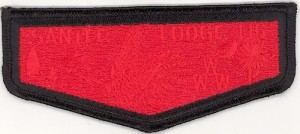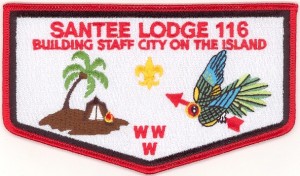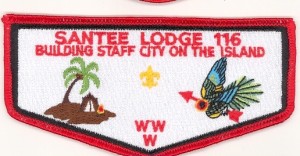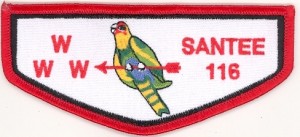-
Subscribe by email
Categories
- Fellowship & Activities
- Fellowship Neckerchiefs
- Fellowship Sets & Stories
- Lodge Flaps
- Lodge Flaps 1957 – 1975
- Lodge Flaps 1975 – 1980s
- Lodge Flaps 2000 – 2005
- Lodge Flaps 2005 – 2010
- Lodge Issues
- Lodge Issues – Contingent Memorabilia
Recent Posts
Patchblanket.com Forum
- DISCLAMER:
Santee Lodge It is not officially affiliated with the Boy Scouts of America, the Girl Scouts of the USA or the World Organization of Scout Movements.
The Death Flap and Island & Trader Flaps
October 24, 2009
The Death Flap and Island & Trader Flaps
 Death Flap
|
After the summer of 1999 Santee Lodge was in turmoil. The lodge chief had been removed, the lodge adviser had resigned (the third in three years) and the scout executive decided to suspend operation of the lodge and reorganize it. During the shut down a district executive who had worked at Camp Coker in the summer of 1999 decided to order a batch of three dozen flaps because the lodge had been closed down. The Death Flap was an all red ghost flap with a black border ordered directly from the Stadri Company and delivered to the council office. He gave out the flaps to various people such as other members of the professional staff and some adults in the lodge. Eventually all of the flaps were collected back up from the people and turned over to the scout executive. David Lee and Jimmy Duffy later burned the flaps behind the dining hall at Camp Coker. However, of the 36 flaps made only 32 were burned. No one seems to know the whereabouts of the 4 missing Death Flaps. |
 Stadri Flap Sold on eBay without rolled edge border or plastic backing
|
Eventually several of the death flaps surfaced on the Internet auction site eBay and were sold by a trader out of Missouri. It was also during this time that some of the Stadri patches including the One Arrow Vigil showed up on eBay for sale by a Canadian wholesale patch dealer. Apparently he got patches from Stadri’s overseas supplier (some missing the border and plastic backing) and sold them starting at $3 each. |
The story of the Death Flap is also the beginning of the story of the “Island” flaps. When the lodge was reorganized after having missed the 1999 Fall Fellowship and 2000 Winter Banquet the first event was a February workday held at Camp Coker. The executive committee met and voted to undertake the project of turning Belk Island into a new staff city area. A motion to sell the Death Flaps as a fundraiser was debated at the meeting. However, the majority of the youth on the committee voted the idea down and no decision was made for a fundraiser.
At the first fellowship after the reorganization in the spring of 2000 the business meeting saw the issue of the Death Flap come to a close. The lodge voted to ask the scout executive to destroy the flaps.
 Jumbo Island Flap
|
The next day at a long Sunday morning executive committee meeting a compromise was reached to meet the goals laid out in the budget to support the island project. The youth finally decided to create a brand new fundraising flap. The flaps were to be sold for $100 to adults and $50 to youth who provided at least 10 hours of service to the camp. The design was done by David Lee, the interim lodge adviser and sent off to the company. However, the first run came back looking “jumbo”. In fact there was some question as to whether they were more of a back-patch than a flap. |
 Regular Island Flap |
The decision was made to order another set of flaps and this time make sure they were the standard size. The executive committee later decided anyone buying the Island flaps would get both the Jumbo Island flap and the Island flap for $100. At the 2001 Fall Fellowship the executive committee made the decision to drop the 10 hours of service requirement and sell the flaps to youth for $50. After over a year of selling almost none of the patches the Executive Committee voted to drop the adult price to $50 and the youth price to $25. By the time this order of slap was completely sold out the price had dropped all the way down to $10 for the Jumbo and $5 for the regular Island flap. Ironically, staff city was never built on the island but the money did go towards the construction of the staff city birdhouse cabins below the dining hall. |
 F3 - Trader Flap |
At the 2001 LLDC in August the executive committee approved a new “Trader Flap” for the lodge. The vote came at the direction of the scout executive in order to have a Santee flap available for open sale in the Florence office. Several designs were drawn up around tables in the dining hall. However, the design which won out was from Brian Howe who used his computer to take the classic Santee twills and create a white twill. Brian added an fleur-de-lis under the “WWW” but otherwise kept the same look as the twills. The youth approved his design because it was very traditional and also because as a twill flap it would not be as desirable as a fully embroidered Santee flap. The flaps arrived in time for the 2001 Fall Fellowship but a little bit of controversy came with them. The Moritz patch company had switched the bird that Brian had proposed and used the bird from the 2001 Fall Fellowship patch to the surprise of the executive committee. Another impact of this change was to drop the fdl that Brian had added to the classic twill look since the 2001 Fall bird has a hidden fdl in the parakeet’s neck. The committee met on Saturday to decide whether to sell the flaps anyways or send them back. The committee decided to send sell them anyways. Randy Dargan wisely made a motion in the business meeting that night that if the patches were reordered that they should keep the design that Moritz sent them instead of going back and using Brian’s design which would have made another lodge issue. |
The original order of the Trader Flaps was for three hundred. Most of them were sold at Fall Fellowship to Santee brothers who were not used to being allowed to buy a Santee Flap open sale. Some flaps were taken by the Staff Adviser to be sold in the council office which of course was the first time this had happened in the lodge. By January 2002 all the flaps in the first run were sold out. The lodge eventually reordered 400 more in the fall of 2002. There is no variation in the second run. The last trader flaps were sold at 2006 Fall Fellowship.
[phpbay]oa patch, 32,13885,,,,25, “”, “”[/phpbay]



Jason,
Let me know when you want the real story behind the design and process of getting the original Trader flap passed. I still have the first design that was submitted to me (drawn on a napkin by David Lee). Brian Howell did not design the Trader flap that was passed, he simply submitted the design (on another’s behalf).